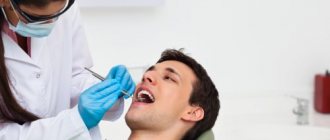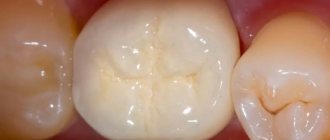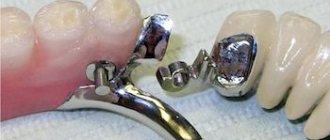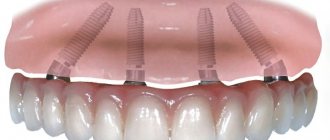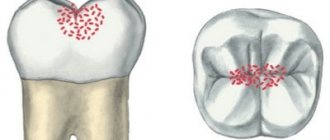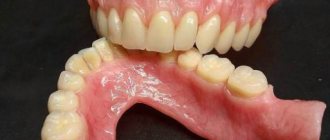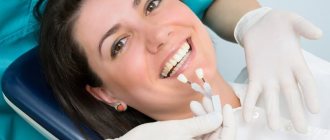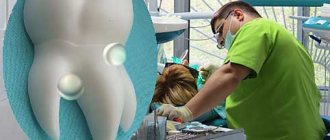After installing a prosthesis (in most cases a crown), unpleasant symptoms can be detected. This is pain, discomfort, swelling, the sensation of a foreign body in the oral cavity, and even suppuration of the tooth. This is due to improper installation of the prosthesis or independent diseases of periodontal tissue. If the material is incorrectly selected, an allergic reaction may develop. Vulture, itching, redness, and swelling appear on the mucous membrane. The troubles don't end there.
It often happens that a removable denture is installed incorrectly by the dentist or by the patient himself after cleaning. This does not mean the doctor is unprofessional; it happens that after orthopedic treatment, the tooth is injured or the enamel cracks. The reason for this may be injuries, biting hard objects, bad habits - holding a needle or coffee bean in your teeth, thread (these are more likely professional bad habits). All this cannot go unnoticed and both the jaw itself and the installed prosthesis suffer. Any complication after prosthetics can be associated with external or internal irritants, but each time it is accompanied by minor or severe pain.
Why does inflammation begin under the prosthesis?
At the present stage of orthopedic treatment, all materials are so carefully selected that the risk of complications is reduced to a minimum. But everything has its exceptions.
Poor canal filling before prosthetics is a mistake not of the orthopedist, but of the therapist. Incomplete filling of the tooth canal leads to the entry of unfavorable microflora into it, which multiplies and provokes inflammation of periodontal tissue. The patient feels pain, swelling at the site of the installed prosthesis, and pulsation. In this case, it is extremely necessary to re-treat and reinstall the prosthesis.
Inflammation may occur under a fixed prosthesis or crown if an instrument is left in the canal during treatment or the canal wall is perforated. In any case, 95% of complications are associated with improper root canal treatment.
A carious cavity under the prosthesis is a complication of prosthetics and is also associated with improper preparation for prosthetics. Caries under a denture develops in two cases: incomplete removal of carious tissues and non-compliance with the rules of sealants during prosthetics. When there are holes for food debris to penetrate, it always leads to the formation of plaque and caries.
What to do if your gums are rubbing
It is worth noting that after the first fitting and installation of a removable denture, as well as after the first days of wearing, the patient may notice a certain feeling of pressure in the gum area. As a rule, problems do not arise if a removable denture was installed for 1 tooth or a bridge was installed. Dentists assure that this is the norm, since the body responded to a foreign object, and the gums became slightly inflamed. After getting used to it, the swelling will gradually go away and the implants will be normal again.
To relieve inflammation in a short time, dentists advise rinsing your mouth with chamomile or string, calendula or aloe. Such plants help soothe tissue. It is also necessary to limit the consumption of foods that can cause irritation to the oral cavity and mucous membranes.
It is important to understand that in the case of a prolonged inflammatory process, it is worth contacting the dentist to check the correct choice of shape and size of the structure, and also, if necessary, make adjustments to the prosthesis.
Restoring chewing function
Many patients, after a long absence of teeth in the mouth, cannot get used to the fact that removable teeth can be used completely for their intended purpose. This leads to patients relearning how to chew food.
To solve this problem, you should not bite off large pieces of food for a while, chewing each piece thoroughly. Also, you should not bite off hard foods for a long time until you get used to the new devices.
You need to get used to chewing on both sides of your teeth alternately so as not to overload your gums.
Solving the problem of drooling
Another frequently asked question among patients with false teeth is excessive drooling from the mouth. This condition is caused by the presence of a foreign body in the oral cavity, which provokes the receptors. To a greater extent, the condition occurs when a removable plate prosthesis is installed.
There is no need to control this process - after a few weeks, the body’s reaction weakens and the salivation process returns to normal. As a preventive measure and habituation, you can drink large amounts of plain water.
Problems pronouncing words and sounds
It is important, after the general condition of the tooth has become accustomed to the presence of dentures, to begin working with diction, since it is impaired in 70% of cases.
In order to eliminate problems with the pronunciation of sounds, dentists advise talking in front of a mirror, pronouncing various words with sounds that are difficult to perceive.
Difficult phrases and tongue twisters, as well as pronouncing words out loud, will be a good help.
Food perception
| Click to sign up for a FREE consultation |
Adaptation to removable dentures occurs, as a rule, without loss of taste, however, a third of patients during the period of adaptation note a decrease in the perception of taste buds.
It is important to adjust the psychological level in order to get used to the new sensation of tastes. Many dentists advise trying every bite of food, trying to feel its taste.
This activity helps not only restore receptor function, but also learn to eat food correctly.
The process of wearing dentures and adapting to them is quite complex, so it is important to adjust yourself on a psychological and physical level. In the first weeks after installation of a removable denture, you must try to follow all the doctor’s instructions in order to adapt your body quickly and painlessly.
How to identify complications after installation of a prosthesis?
If there are doubts about the normal state of the mucous membrane under the prosthesis, you need to pay attention to several specific manifestations.
Swelling of the gums is a sure sign of the onset of the inflammatory process. The accumulation of purulent exudate under the gum can lead to serious consequences, and in this case you need to contact a dental surgeon. Swelling or gumboil can cause not only pain, but also tooth mobility, and this will lead to the need to replace the denture.
Fistula - acute inflammation of periodontal tissues can result in gumboil. And if the acute period of the complication went unnoticed, then the appearance of a fistula cannot be missed. If the fistula closes, acute inflammation begins again.
Cyst - if adequate treatment of chronic periodontitis was not carried out before prosthetics, it will end with a cyst. The cyst contains pus and appears on an x-ray as a black spot. The symptoms of a cyst are similar to periodontitis - pain when biting, swelling in the area of the causative tooth.
Causes of complications
After installing dentures, if signs of pathological processes appear in the oral cavity, you should immediately contact your dentist to eliminate the problem. The main reasons for complications during dental prosthetics are:
- insufficiently thorough preparation for the manipulation, which consists of refusing the proposed dental treatment, sanitation of the oral cavity and elimination of caries;
- incorrectly selected size of the prosthesis, resulting in discomfort while wearing it;
- poor-quality installation of the structure, which caused the appearance of gaps and cracks, the accumulation of food debris between the teeth, as well as the occurrence of inflammatory processes in the gums;
- breakage, damage or displacement of the denture;
- decreased immunity or allergic reactions caused by dental construction materials;
- displacement of individual teeth, resulting in movement of the entire structure as a whole;
- non-compliance with the rules of oral care after installation of a denture.
What to do if there is inflammation under the prosthesis?
The first thing to do is contact your doctor or, better yet, go to a good dental clinic that will offer several treatment options.
If prosthetics involves installing a pin, treatment becomes more complicated, since removing it from the root canal is quite difficult and can result in a root fracture. After this, the tooth will have to be completely removed. The issue of repeated prosthetics is quite complicated, since a root fracture can damage the bone plate and the implant cannot be installed, just like any pin.
When the cause of a complication after installing a crown is improper treatment of the canals, again the refilling is difficult and may result in perforation.
When it is possible to unseal the canal or remove the pin, anti-inflammatory therapy is carried out. After this, the canals are re-filled and a new prosthesis is installed.
We can conclude that it is better to carry out painstaking preparation for prosthetics and take into account all possible complications before installing the prosthesis, rather than treating the resulting inflammation.
How to get used to increased salivation or dryness
Increased salivation always goes away on its own. But if you wish, you can speed up this process. There are several proven methods for this:
- — After eating, you can rinse your mouth with water pepper extract diluted in water.
- - You can rinse your mouth with a decoction of Lagochilus intoxicating.
- “Rinsing with shepherd’s purse tincture also has a positive effect.
- — Viburnum berries poured into boiling water reduce salivation. The resulting infusion can be drunk and used for rinsing.
To eliminate dry mouth, you need to drink small sips of water as often as possible. It will also be useful to increase the amount of juicy vegetables and fruits in your daily diet. Dry mouth will be relieved by periodically sucking on low-sugar candies.
Among the folk methods there are also many that will eliminate dry mouth. Decoctions of chamomile, calendula, and St. John's wort not only reduce dry mouth, but also fight pathogenic microbes, help strengthen the gums, and help with inflammation of the mucous membrane. To prepare such a decoction, dry parts of the plant are poured with boiling water and left to infuse for several hours.
How can I make it easier for myself to adapt and get used to a lower removable denture?
If the denture is very poorly fixed on the jaw and dangles, if the jaw is flat and there is nothing for the denture to grab onto, then you can use special means to improve the fixation of the removable denture. These are various adhesives and gaskets.
Many patients do not wear their dentures all the time, and they especially often take them out at night. There is no such need; to get used to it, it is better to wear the prosthesis around the clock. Nothing bad can happen at night, the prosthesis simply cannot be swallowed or choked on, it is much larger than a person’s throat. In the worst case scenario, you may wake up and the denture is not in your mouth, but lying next to you on the pillow. You shouldn’t take breaks during the day either, even if your jaw and gums are tired, you want to rest. At this moment, when you remove the prosthesis, the jaw and mucous membranes become unaccustomed to the prosthesis, and when an hour later you put it on again, everything starts all over again. At the same time, the jaw and mucous membranes become even more tired. Often, patients who take breaks simply stop wearing such a prosthesis after a few days.
Preparation and full diagnostics before prosthetics
It is impossible to make comfortable dentures without a responsible approach to diagnostics before prosthetics and to the preparation of the oral cavity. In order for dentures - acrylic, nylon, clasp and others - to be comfortable, you need to undergo several studies. All of them will be useful for identifying contraindications, as well as for accurately modeling the prosthetic structure.
The first thing in diagnosis is an x-ray, panoramic image (OPTG) or CT (computed tomography) of the jaw. The second is taking impressions or impressions of the teeth. By the way, today you can make not ordinary impressions, but digital ones - using an intraoral scanner. The third is functional diagnostics, where bite parameters are assessed in dynamics, i.e. how the patient chews. This is one of the most important factors for making a prosthetic product comfortable. Otherwise, it can only be worn for beauty. Such diagnostics consists of assessing the work of the masticatory muscles, the movements of the jaw joints, and the closure of the jaws during movement.
Read on the topic: digital diagnostics before prosthetics - how modern devices help make comfortable dentures.
As part of the preparation, it is necessary to cure all identified dental diseases - eliminate caries, pulpitis, properly fill and strengthen the root canals. So that later the supports under the prosthesis do not fail, and it does not wobble, it fits tightly.
Complex on 4 OSSTEM implants with delayed loading - from RUB 170,000.
Complex implantation Osstem (South Korea) with delayed loading after 4-6 months.
Guarantee for the doctor’s work - unlimited Call now or order a call
Opening hours: 24 hours a day - seven days a week
Fixation means
Almost all people who wear removable structures are familiar with fixation cream. Popular brands are Corega, Protefix, Fittydent, LACALUT, PresiDENT. There are also fixing pads and powders based on sodium alginate. All these products are applied to a cleaned, moistened denture, it is installed in place and glued to the gums.
Manufacturers claim that in this way, a poorly fitting structure will gain good fixation for 8-12 hours. But in practice and according to patient reviews, the action lasts only a couple of hours or even before the first meal.
“When they made an acrylic remover for me, I couldn’t use it without cream at all. Food got stuck under my gums, which was not pleasant. The clasps did not cling well to the teeth. Corrections at the dentist also did not help much. So I save myself with cream, although I still can’t chew something tough like shish kebab. And the cream has a specific taste, you need to get used to it.”
Evgeniy Nikolaevich, review from the dentistry.rf forum
Professional correction: relining, editing
Adjustment of a removable denture (relining, editing) is an adjustment of its dimensions to the changed anatomy of the prosthetic bed. Since bone atrophy does not stop when wearing such structures, and sometimes even intensifies, over time the base will not fit tightly, will begin to wobble and fall out. To increase comfort, the doctor can file down protruding areas or build up the acrylic base during the appointment - this is a clinical method. It is fast, but there is a higher risk of the patient becoming allergic to acrylic, and lower reliability.
Relocation of removable structures should be carried out according to indications. On average, every 3-6 months, depending on the rate of atrophy and the softness of the base material.
With the laboratory method, new impressions must be taken from the jaws and sent to the dental laboratory along with the prosthetic structure. The technician will modify the product in accordance with the new parameters so that it fits tightly to the atrophied areas. This method is optimal in terms of convenience and durability, plus the risk of allergies is much lower. But the adjustment will take more time - up to 5-7 days.
Proper production of dentures
During the manufacturing process[1], it is important to follow all the nuances of the technological process (it is different for each material). If a mistake is made at any stage, then a defect may appear in the product, and the fit will not be tight. Chewing with such “teeth” is not only inconvenient, it is impossible.
Therefore, choose experienced orthopedic doctors. Also, priority should be given to clinics that either have their own dental laboratories or have entered into an agreement with a large modern laboratory.
Why is it more difficult to get used to a complete removable denture on the lower jaw?
The upper complete removable denture, due to its shape and anatomical features of the upper jaw, sticks to the palate and holds quite well.
People have little trouble fixing it. The greatest difficulty in getting used to is the lower complete removable denture. This is due to the fact that when not a single tooth is missing, there is a difficult fixation of this prosthesis on the lower jaw. The lower complete removable denture cannot adhere to the lower jaw, it simply lies on it.
The situation is further aggravated by the fact that the tongue is attached to the lower jaw. As the jaw moves, this powerful muscle begins to move and releases the denture. The masticatory muscles are also attached to the lower jaw, which at the moment of chewing also begin to move, move the mucous membrane and try to remove the denture. In addition, the anatomical complexity of the mucous membrane on the lower jaw complicates the adaptation and fixation of a removable denture, since it is looser, softer and less attached to the bone compared to the upper jaw.


